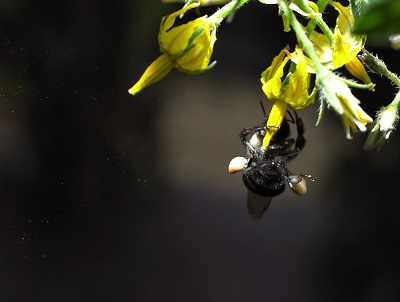
Why can a large number of plants and small animals coexist in equilibrium in a single square meter? Why doesn't the most competitive plant or the fastest eating insect dominate everything? It seems that the way animals and plants interact is important but proving these models in nature is not easy. Mathematical models that try to describe how these communities work are often used to answer these questions.
A group of researchers from the Doñana Biological Station (EBD-CSIC) and the University Institute for Marine Resarch (INMAR) from the University of Cadiz have carried out the first experimental test proving that the way species interact determines how they can coexist. "For example, mutualist interactions established with pollinators relax competition between plants, allowing a great number of species to live together", explains Ignasi Bartomeus from EBD-CSIC and first author of the article. In this study, published in Proceedings of the National Academy of Sciences (PNAS), researchers from the Massachusetts Institute of Technology (USA) and the University of Fribourg in Switzerland also contributed to this study.
Preventing some species to interact can change the entire ecosystem
17 mesh boxes of 3 cubic meters each were built to develop the research. Plants and insects of different species were placed in each box. The experiment consisted of studying how plants and insects interact with each other, as well as identifying the status of each species. Subsequently, researchers prevented the interaction of species of bumblebee with the flower they most frequently visited to eat.
After breaking this interaction, they studied what happened to the rest of the species. The result was that the entire community of plants and animals changed their behaviour. "In nature everything is connected, so when you change an interaction between two species, the change spreads throughout the interaction network. It's like when you throw a stone in a lake and the waves affect the entire surface. This cascade effect forces species to adapt to the new situation", explains Bartomeus.
The researcher Óscar Godoy, from the Department of Biology and the University Institute for Marine Research (INMAR) of the University of Cádiz emphasizes the importance of this study: "We are mixing different theories, those related to the ecological niche and those related to interaction networks, to study complex effects on ecosystems. But since numbers and mathematical models support everything, we first did this experiment to give us clues as to what are the limitations of current modelling processes that do not take into account important phenomena that occur in nature, such as complex chain reactions observed".
A fragile balance
The experiment has shown how complex ecosystems are and that modifying the interactions between species in an ecosystem alters the behaviour of the entire community of plants and animals in a way that is difficult to predict. This means that the elimination of species can have unknown chain effects on the rest of the ecosystem that may be underestimated. "Assuming that a loss in nature does not have secondary effects is not correct, since species are related in a complex network of interactions, and changes in that network affect the entire ecosystem," says Ignasi Bartomeus.
In practice, the implications of this study reveal that it is necessary to be very careful when producing changes in an ecosystem, since the balance is delicate. "It often seems that, from ecology, we only focus on narrating this gradual destruction of ecosystems but, if we want to take measures, we must, in addition to documenting this process, understand how ecosystems work, and how they can persist in the face of disturbances" says Bartomeus.
This study opens up new fields of research. According to Óscar Godoy, "now the challenge is to understand and predict the chain effects that we observe in natural ecosystems with a high number of species. Only then can we better deal with the problems derived from the extinction of species".
Reference:
Ignasi Bartomeus et al. Experimental evidence of the importance of multitrophic structure for species persistence. PNAS https://doi.org/10.1073/pnas.2023872118



